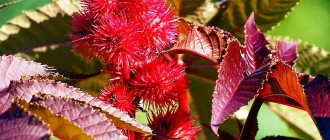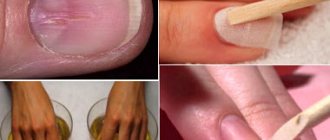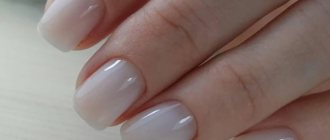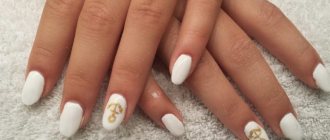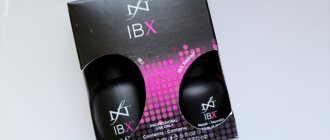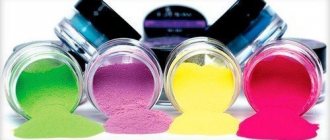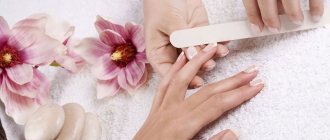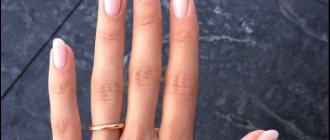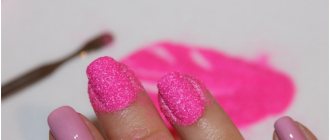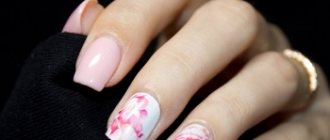Beautiful and strong nails are one of the important components of the impeccable image that every woman strives for. Well-groomed hands with a neat manicure can become a real calling card of their owner. But, unfortunately, very often the problem of delamination of the nail plate arises, which spoils both the appearance and the mood. We'll tell you how to avoid this and what to do if your fingernails peel.
The way our nails look depends very much on both the state of the body and many external factors. When faced with such an unpleasant thing as splitting nails, you must first figure out what could have led to this.
Essence, Anti Split Nail Sealer Base Coat
Base against nail splitting (8 ml).
232 rub.
Expected
Essence, Anti Split Nail File
File against splitting of thin nails.
144 rub.
Expected
El Corazon, Preparation “Iron Hardness” No. 418, 16 ml
Preparation (16 ml) for soft and brittle nails.
(143)
180 rub.
180 RUR Buy
Why do nails start to peel?
To answer this question, let's look at the structure of the nail. The nail plate is a keratinized structure consisting of many layers of cells. Its formation begins in the matrix located under the skin of the lower (proximal) nail fold. It is partially visible as a white semicircle at the base of the nail, but most of it is hidden under the skin. Future nail cells are continuously born in the matrix. At first they are round in shape and white. But as they move towards the free edge, they flatten, keratinize, become transparent, and layer on top of each other. The number of layers normally reaches 100. In this case, the liquid released from the cells during flattening acts as cement, which glues the layers together and makes the structure of the plate strong and unified. If for some reason a failure occurs during the formation of the nail, then the layers no longer “stick together” so firmly, which leads to its delamination at the free edge. Factors causing onychoschisis are divided into two groups: primary and secondary. Primary cases include cases when a plate with the correct structure splits due to constant negative external influence. Secondary are internal diseases that lead to deviations in the formation of the nail. As a result, it grows weakened and easily splits. Damaging external factors include:
- repetitive microtrauma, such as hitting the keys while typing, playing the piano or playing the guitar;
- injuries caused by excessive nail length;
- mistakes in the technique of performing manicure or pedicure, using metal files, working with files in different directions;
- modeling with acrylic gels;
- habit of biting your nails or fiddling with your hands;
- contact with chemicals, solvents, varnishes, removers with acetone, which dissolve fats in the composition of the plate and damage the strength of its structure;
- contact with detergents and cleaning agents without protective gloves; compositions with an alkaline pH are especially dangerous;
- tearing off gel polish or other artificial coatings;
- frequent repetition of the procedure of wetting and drying hands by cleaners, nurses, and hairdressers, leading to injury to the nail.
The factors listed above are especially harmful for nails with a slow growth rate, because then the time they act on the same cells of the plate increases. Internal causes lead to onychoschisis:
- fungal infection;
- psoriasis, eczema, lichen planus;
- vascular disease, poor blood flow to the extremities, age-related decrease in blood circulation;
- metabolic disease;
- endocrine disorders (hyperthyroidism, hypothyroidism, diabetes mellitus);
- malnutrition, depletion of the body due to illiterate diets, leading to a deficiency of vitamins, microelements, amino acids;
- autoimmune connective tissue pathologies;
- infections;
- intoxication;
- internal use of drugs from the group of retinoids.
Onychoschisis occurs more often in women and older people, which is due to the structural features of the nail plate. Aging is characterized by physiologically increased fragility of nails. Women use household chemicals, come into contact with water, and perform decorative manicures, which, if safety rules are not followed, injure the nails. Dissection occurs in approximately 10% of pregnant women. Also, such dystrophy occurs in children due to the habit of sucking fingers.
The mechanism of formation and causes of peeling nails
Nails are horny plates located on the phalanges of the fingers and toes, performing a protective function. Their basis is considered to be keratin, which is responsible for strength, which is arranged in layers, combined with particles of lipids and water. Healthy nails, due to the structural layers tightly pressed together, have strength, shine and elasticity.
For certain reasons, tiny gaps appear between the layers of the nail plate, increasing in size over time. These dystrophic changes split its homogeneous structure into separate scales. Delamination can occur in the transverse and longitudinal direction.
The formation of peeling nails can signal an independent problem or be a sign of a serious illness. Outwardly, they look very unattractive, have increased fragility, roughness, brittleness and dryness.
To successfully combat this problem, the true cause of its occurrence must be established. To do this, you need to pay attention to nutrition, lifestyle, and conduct medical examinations to identify certain diseases.
The most common causes of peeling nails are:
- unbalanced diet;
- negative effects of hot water and household chemicals;
- improper care and use of cosmetics;
- hidden diseases of internal organs and systems;
- mechanical damage;
- professional activity;
- lack of body hydration;
- long-term stressful situations, etc.
Separation of fingernails and toenails often occurs due to an unbalanced diet, which results in a deficiency of nutrients in the body. Especially the nail plates suffer from a lack of calcium, magnesium, silicon and protein. Insufficient iron content in a person’s blood threatens the development of anemia, which immediately negatively affects their condition.
Exfoliating nail plates appear with decreased immunity, endocrine diseases, pathologies of the thyroid gland, disturbances in the gastrointestinal tract and other diseases.
If the cause of nail separation is identified, measures should be taken immediately to eliminate it.
How does it manifest?
A characteristic sign of onychoschisis is splitting of the nail in the transverse direction with the formation of thin scales or plates running parallel to the free edge. Dystrophy is more common on the arms than on the legs. Usually the index, middle, and ring fingers are affected. The severity of dystrophy varies: from one superficial splitting with the formation of one layer to two, three, four transverse separations, which occupy a third of the upper part of the plate in area. Often dystrophy is combined with onychorrhexis or longitudinal splitting of the nail. What onychoschisis looks like, look at the photo: If you cut off the free edge with a slight delamination, then outwardly such a nail will look healthy, but as the plate grows, the violation will appear again. Onychoschisis does not affect nail growth. Typically, only the free edge or distal part of the plate is affected. But with psoriasis, lichen planus, or while taking retinoids, there are cases of splitting at the base of the nail or in the proximal part. Sometimes the structure and strength of the nails change. They become soft, brittle, thin, and inelastic. With a fungal infection, the nails thicken, look gray, yellowish or dirty white, and the surface of the plate becomes rough. Onychoschisis does not cause pain, but it increases the likelihood of accidental tearing, splitting, or breaking off the nail. People complain of serious cosmetic problems and difficulties in daily and work activities. Nails cling, small debris gets between the layers. For women, for example, it is difficult to put on nylon tights, as the risks of getting snags and arrows increase.
Treatment methods
Treatment usually takes several months. Main tasks:
- strengthen the plate;
- smooth out unevenness;
- increase nail hydration;
- eliminate the cause of violations;
- restore nutrition to the nail matrix;
- prevent the problem from occurring in the future.
Local nail treatment, oral medications, physiotherapy, and massage are used. To eliminate the cause:
- In case of fungal infections, hardware cleaning of the damaged areas is performed. Depending on the area of the lesion, ointments, creams, varnishes or complex therapy are prescribed, which includes both local treatment and oral administration of drugs against the fungus;
- For nervous disorders manifested in the habit of biting nails, consultation with a neurologist and the use of sedatives to stabilize the emotional background are indicated;
- In case of injuries or damage to the nail plate by chemicals, use protective gloves;
- In the case of chronic skin, endocrine or vascular diseases, their treatment is adjusted;
- If there is a nutritional deficiency due to malnutrition, the diet should be enriched with foods containing protein, healthy fats, vitamins, and minerals.
Externally, to strengthen nails, apply moisturizing, nourishing creams, masks, fortified varnishes, make medicinal oil or salt baths, and applications with oil solutions of vitamins. Medicines that help boost immunity, vitamins, microelements, amino acids, and unsaturated fatty acids. They participate in the metabolic processes of the tissues of the nail apparatus, in the formation of nails and are part of the plate. The most important vitamins for nails are group B (B7, B6, B12), E, C, A, minerals - calcium, phosphorus, zinc, amino acids - cysteine, arginine, glutamic acid. Cysteine is a structural component of the keratin protein that makes up nails and is responsible for strength. Massage of the hands, fingers, and feet helps to increase blood flow to the nail apparatus and speed up metabolism in tissues. If there are infectious complications due to accidental tearing of the nail, antiseptic treatment is performed and medications are prescribed that accelerate the healing of damaged tissues. When treating onychoschisis, careful nail care is needed to speed up recovery:
- Follow the doctor's recommendations;
- Wear protective gloves when in contact with aggressive chemicals, detergents and cleaners. When doing “wet” work, you should first wear thin cotton gloves and rubber gloves on top;
- Keep nails short to reduce splitting;
- Apply moisturizing, nourishing, emollient products to nails, hands and feet.
Onychoschisis is a fairly common problem, especially among women.
It is better to immediately entrust the decision to specialists who will find the reason and make the nails look neater. They will also tell you how to properly care for them in order to prevent complications and recurrence of the situation in the future. For any problems with nails, come to the Eva Korneeva Podology Center in Moscow. Sign up by phone. We will help you keep your nails beautiful and healthy! podology onychoschisis
Elimination of nail plate pathology using folk methods
Traditional medicine will help restore the peeling structure of the nail plates at home. They include a variety of simple procedures: masks, baths, compresses.
You can name some effective recipes for healthy nails that our grandmothers used:
- A solution of sea salt serves as an excellent strengthening agent.
- A mixture of apple cider vinegar, any vegetable oil and vitamin A helps to quickly restore the damaged nail surface.
- Frequently rubbing cranberry juice into the nail plate helps saturate it with essential nutrients.
- A compress of warm vegetable oil with the addition of a few drops of iodine has antibacterial properties.
- Warm beeswax perfectly nourishes nails and finger skin.
- Massaging the cuticle with a soft brush using glycerin will help activate blood circulation in the fingers and prevent the formation of cracks.
- A nail mask made from red pepper has good strengthening properties.
- Vitamins A and E, rubbed daily into each damaged nail, will help significantly improve its condition.
After any procedures, you should use a nourishing cream.
